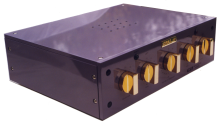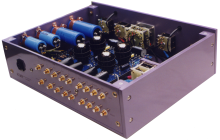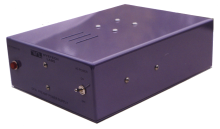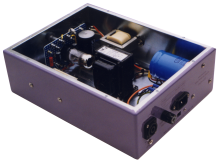Line stage preamplifier
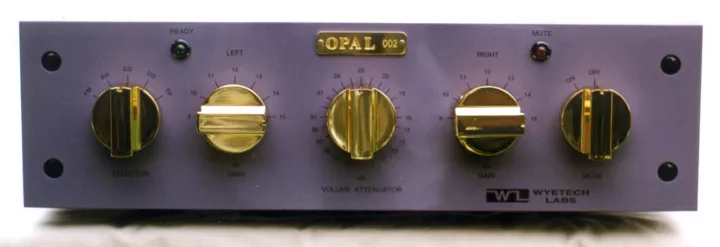
Design Implementation
Audio Circuits
In our pursuit of the benefits of each circuit topology we ended up choosing a grounded grid configuration. This satisfied our design goal for an exceptionally wide bandwidth that extends well beyond 250,000 hertz. The result is a circuit that highly exceeded our expectations and allowed us to fully implement our primary design philosophy that less is better than more. Being perfectionist, we weren't interested in building the best line amp, we wanted to build the perfect line amp. We proceeded in this direction knowing full well that only GOD could pull that off. So what we ended up with is a circuit of the utmost simplicity that is 99.999% perfect. We do regret that so far we have not been able to pinpoint during our listening sessions just what that 0.001 % of imperfection is doing to the music. We have read in print of one solid state guru who has lambasted all single ended tube circuits as being so simple that a monkey could design them. We would like to assure everyone that we are not monkeys, we just like to keep things simple. Remember that Einstein's formula of E = mc² is about as simple as it gets and it took a lot more than monkey brains to arrive at it.
Power Supply
Of course, nothing is free in this life and to get the best performance out of a superior circuit, one has to feed it with the absolutely purest power attainable. This is the reason why half the weight in our power amp is the result of the power supply components we use and why the line amp makes use of a separate power supply to contain all the magnetic components. It is also why the final filter stage of the power supply must reside in the amplifier chassis and be as close as possible to the active circuits. This final filter stage is of course of the non-magnetic variety, namely a RC filter network. As if three stages of filtering wasn't enough, each channel board has its own large value polypropylene capacitor as a final shunt bypass cap. We have been accused of overkill and we admit that we are so convinced of the importance of pure power that we might be guilty of doing just that when it comes to power supply design. The OPAL power supply completely eliminates all noise and ripple on the DC 200 volt line while also maintaining regulation of the voltage to within 0.002 volts/second of drift. This far outperforms what a battery pack could do !
Parts
We use precision quality parts throughout. Our fixed terminal hand crafted circuit boards, while costing many times more than an equivalent printed circuit board, are well worth the expense and labor to assemble them. The sonic improvement alone warrants the expense. The ease of replacing parts and the tenfold increase in lifetime durability are added benefits resulting from this board construction. These boards are held elevated from the surrounding metal chassis to avoid any capacitive coupling between components. We do considerable lab testing in our selection of components. Since perfection is our goal, we don't think parts should impart a signature sound but rather allow the sound to flow through unaltered. The type of parts used therefore must have a synergistic relationship to the circuit they are placed in. It is this relationship of which type of part to use where, that ranks our products apart from the crowd!
Circuit Description
This line amp uses a grounded grid configuration which is isolated by a cathode follower stage before and after it. All three stages are non-inverting thereby maintaining absolute phase. The grounded grid configuration is known for its extremely wide bandwidth and was the reason we chose this topology! The grounded grid stage drives two cathode followers which provides two isolated outputs for each channel. All stages are DC coupled and only one capacitor is used in the output stage for DC blocking. No feedback is used and dual mono construction is implemented using separate circuit boards for each channel.
Power Supplies
A unique design for the power supply was implemented in order to eliminate all ripple & noise while maintaining a constant voltage regulation of the 200 Volt DC power line effectively acting like a large battery power source. A combination of large chokes, electrolytic and polypropylene capacitors are used to implement three stages of filtering. The output from the second stage is split in two to form a dual third stage filter to eliminate any channel crosstalk through the power supply. This is accomplished using a tube rectifier in a choke input filter configuration followed by successive LC and RC filter stages using only passive components to accomplish regulation and noise suppression. A 3 element pi-filter is used to provide DC to the filaments. Further noise reduction was accomplished by containing the power supply in a separate chassis.
Mechanical Construction
- Machined aluminum plates 1/4 in (6.35 mm) & 3/8 in (9.525 mm) thick bolted to square post are used to construct the preamp chassis. This provides 100% shielding from external RF fields.
- 14 gauge all welded steel chassis for power supply to contain magnetic fields.
- Plated solid machined brass knobs for smooth operation of rotary switches..
- All switches are Shallco coin silver contacts with stainless steel shafts.
- Non magnetic stainless steel hardware is used throughout.
- DC shielded power cord using Neutrik 30 amp connectors at both ends.
Circuit Boards
(Hand crafted Vectorboards using precision double turret terminal posts)
The components are mounted on Vector boards which contain swaged terminal post. These posts are divided into two areas. The wiring used is laid out on both top and bottom of the board and is soldered to the bottom layer of the terminal post. This point to point wiring allows the highest possible component density while maintaining the shortest possible SIGNAL PATH! The components are then soldered into place on the top layer of the terminal which allows the replacement of any part without removing the circuit board. High quality Teflon coated Silver plated OFHC copper wiring is used where appropriate and silver solder is used throughout.
Automatic Power Sequencing & Muting
About 10 seconds after the filaments light up the DC rails are slowly brought up to full voltage of 200 Volts over a period of 60 seconds. At the end of 90 seconds the auto-mute is disengaged completing the turn on sequence. Muting is accomplished using a 4-pole relay that shorts the preamp outputs. When disengaged the muting circuit is not in the signal path.
Specifications
Tube Complement
(4) 6SN7WGTA NOS (military specifications) Dual Triode
(1) 6x5 NOS (military specifications) Dual Diode
Frequency Response
(reference to a sine wave at 3.5 Vrms output)
- +/- 0 dB flat — 20 Hz to 100 KHz
- + 0 dB/ -1 dB — 6 Hz to 375 KHz
- + 0 dB/ -3 dB — 2.6 Hz to 750 KHz
Input Impedance
50 Kohms minimum
Absolute Phase
non-inverting
Master Gain Controls
Left and right variable from 9 dB to 15 dB (in 1 dB steps)
Channel Balance Control
Use left or right channel gain controls.
Attenuation
24 position stepped volume control (12 steps of 1½ dB/step)
Output Impedance
425 Ohms
Rated Output
3.5 V RMS (maximum = 20 V RMS)
Slew Rate
Greater than 40 Volts/microsecond.
Outputs
2 pre-amp outputs, 1 tape output, 1 line level output.
Inputs
4 line level inputs, 1 tape input.
Power Requirements
Switch selectable 115/230 Volt, 50/60 Hz, 50 Watts
Weight
| Net (Preamp) | 38.5 lbs | 17.5 kg |
|---|---|---|
| Net (Power Supply) | 18 lbs | 8 kg |
| Shipping | 66 lbs | 30 kg |
Dimensions
| Width | Depth | Height | |
|---|---|---|---|
| Preamp | 19 in (48.26 cm) | 14 3/8 in (36.5125 cm) | 5 1/4 in (13.335 cm) |
| Power Supply | 9 in (22.86 cm) | 12 in (30.48 cm) | 3 1/2 in (8.89 cm) |
Reviews
The Absolute Sound
issue 137 (August/September 2002) - Reviewed by Harry Pearson
HP'S Choice: Line Stages included the Opal in its list.
…I did not anticipate that the two-piece Opal would be the masterpiece it is.
…uncannily transparent… downright supernatural… seductive to listen to…
The Absolute Sound
issue 143 (August/September 2003) - Reviewed by Harry Pearson
HP'S Super Components List Part II included the Opal in its list.
…The Opal is one of those audio fascinations that come down the turnpike every few years. It sounds quite unlike any of the other the line stages I rounded up for that massive comparison.
The Absolute Sound
issue 127 (December 2000) - Reviewed by Dan Davis
Reading this review leaves no doubt that Dan was deeply impressed with the Opal's admirable sound qualities. We are proud to say that Dan whispered to us that a gang of Mounties couldn't pull the Opal away from his grasp, and that he preferred to buy it from us than give it back.
There aren't many products that can transform an audio system. The Wyetech Opal line-stage preamplifier is one of them.
…my experience with the Opal proves it by far the best preamplifier I've ever had in my system.
The Opal brought a new airiness and ease to large-scale music even at lease-breaking volumes…
I was also left convinced that the Opal is an extraordinary instrument, one to set among the best High End components.
The Inner Ear Report
Volume 10, # 2 (1997) - Reviewed by Ernie Fisher
…this preamp simply provides better sound than any other units we have auditioned – bar none…
Warranty
Limited Warranty
Tubes 1 Year Parts
Components: 5 years parts & labor

